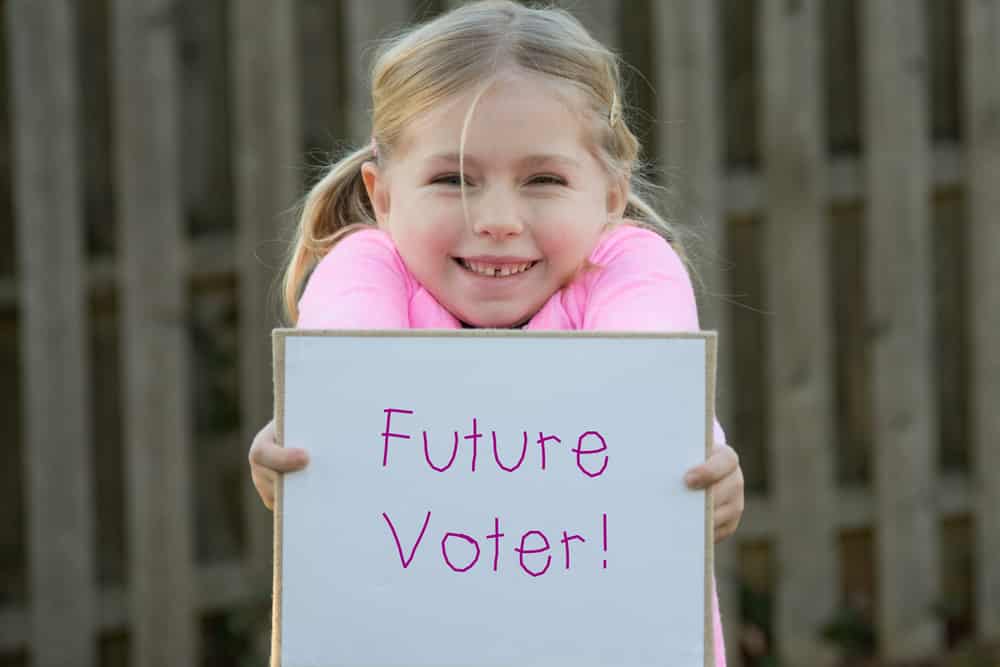It might be challenging to explain the two main political parties in the United States, especially to a young audience. The world is a political place. Politics appears in news reports. Children will see and hear a lot about politics, especially during election season.
It can be challenging to find a way to explain politics to kids that is both simple to understand and respectful of the various points of view. Because children are often too young to appreciate the complexities of politics, here are some pointers on how to explain the two parties in America to kids so they can distinguish between them.
Why It’s Important to Teach Kids About Politics
Educating your child on political topics goes beyond simply encouraging them to cast a ballot when the time comes. Even young children have to understand the importance of legislation since it governs everything we do in daily life. Children will learn about concepts like regularity, sharing, and rationality even in their first year of elementary school. Even if they don't seem overtly political, these are all crucial for surviving in a democracy.
Children typically have a ton of questions about political matters, especially during election seasons when they notice the banners in people's windows, and so forth. It will help children learn if you answer their questions about local and central government operations rather than brushing them off as things your child doesn't need to worry about.

©Holly Vegter/Shutterstock.com
Social Responsibility
Early exposure to political matters can also help to instill a sense of social responsibility in your child. Children typically focus on the things that are important to them, but governmental issues also involve thinking about how they affect other people. Also, engaging with governmental issues can help kids develop their own opinions and learn how to consciously protect them.
In addition, we frequently emphasize that tomorrow's leaders are today's young. It is our duty as parents, guardians, and mentors to ensure that they are well-informed about the political climate of the nation in order to ensure that our nation has a future filled with duly-educated citizens. This prevents your child from becoming apolitical. Being apolitical in the modern world is most definitely not what we want. A child ought to be well-equipped to choose sides when necessary. Children's political interest needs to be piqued in order for them to grow up to be informed adults capable of making the best choices for themselves.
How Do You Get Ready for the Discussion?
When youngsters overhear something in the heat of the moment, there isn't always time to prepare for the talk. Tell them you'll talk about it soon and keep your word if you don't feel ready to do so. Spend some time preparing what you will say in the interim. Find out what your child already knows by asking them where they first learned about the Democrats and Republicans. Take this knowledge as a starting point.
Tell your child that even though everyone has unique perspectives and opinions, cooperation is necessary for a harmonious society to exist. You might be asked challenging questions during these unpleasant conversations. It's acceptable to admit to your little one that you don't know the answer to something and that you'll look it up.
When it comes to discussing touchy subjects with kids, such as abortion or gun control, which you might find difficult to do, go with your gut and their lead, based on their knowledge and age. Topics that could be better left for later should be avoided, and if you are directly questioned about a complex subject, keep your response concise. Be patient, take your time, and keep in mind that you can always bring up these points again in the future.
Differences Between Republicans and Democrats
Start with the fundamentals when educating a child on the differences between Democrats and Republicans. Describe how the Democrats and the Republicans are the two main political parties in the United States. Talk about how they both have different views on how the government should operate and various other issues that have an impact on the nation.
In 1828, the Democratic Party was founded. It frequently relates to larger government initiatives and heavier responsibilities. The terms “the left-wing,” “reformists,” or “liberals” are regularly used to refer to members of the Democratic Party. These nicknames typically refer to their more liberal political ideas. The Democratic Party, which is usually represented by the color blue, is basically a managing party, organized on developing and implementing governmental policies.
On the other side, abolitionists who opposed subjection founded the Republican Party in 1854. It is frequently associated with less intrusive government and cheaper prices. Republican Party members are frequently referred to as “traditionalists.” The Republican Party hosts transform into an attack group that is organized on inciting and carrying out political animosity.
Republicans are commonly referred to as the Grand Old Party, or GOP for short. The term “the gallant old party” refers to how they were known throughout the Union's successful defense. Because of their propensity for conservatism, they are often known as conservatives. The term “right-wing” is also frequently used.
Democrats support popular sovereignty or a system of majority rule. The most well-established and vigorous ideological bloc in the world is the American leftist alliance. They have a stronger inclination toward liberal thought.
Republicans may refer to someone who favors a republic, a form of government that isn't an autocracy or a government and is typically associated with the rule of law.
Ideologies
Once you've covered the fundamentals of the two parties, it's time to go over their respective ideologies. You can explain that Democrats think the government should offer its people certain benefits and services, such as education, healthcare, and social security. Democrats also support environmental preservation and expanding possibilities for advancement.
In contrast, Republicans think that people should be in charge of their own success and that the government should be less. They favor fewer regulations from the government and lower taxation. They support both fostering economic progress and defending individual liberties.
Explaining To a Child About Democrats vs. Republicans
Using examples is a practical method to simplify complex subjects like the difference between Democrats and Republicans. Prior to that, you should take the age of the child into account when speaking with and educating them. Use your best judgment and be sure to talk to them in an age-appropriate way.
Use Color and Animal Representations: Ages 3-5
Don't forget to pay attention to their requirements during the entire talk as well. The colors of each party make ideal examples to use while speaking to a child between the ages of 3 and 5. Democrats use the color blue, while Republicans use the color red.
Another strategy is to show them illustrations of the two political parties as animals. An elephant for the Republicans and a donkey for the Democrats.
It's also beneficial to let them know that each group's members decide on issues affecting their area and state. These choices may affect the construction of new parks or roads, as well as the number of instructors employed in schools.

©LightField Studios/Shutterstock.com
Explain that Political Parties Have Many Points of View: Ages 6-9
Be careful to pick components from examples that they can relate to and understand readily. If the child is between the ages of 6 and 9, explain that political parties have many points of view. Give them examples to consider, such as the structure of their neighborhood or school. They will be able to think about alternative methods as a result. Also, it enables children to reflect on the choices that must be made in order for the school or community to run smoothly.
The amount of buses that are available is one topic to talk about. Other things to consider are the teachers at the school and the subjects they cover. You can change the subject to something that has a far wider context. From this point on, kids will understand that there are numerous concepts and strategies for meeting everyone's demands.
Discuss the Parties' Philosophies on Taxes: Age 10+
When a child reaches the age of 10, you can start a conversation about taxes. Mentioning who pays for these and how the tax money is spent is also important. Of course, let the kid know that the Democrats and Republicans hold different opinions on the matter. When they are ready to be introduced to a topic, you can start bringing it up.
Each youngster will have a different level of comprehension, so this is by no means a universal guide for discussing Democrats vs. Republicans. When it comes to what kids are ready to understand, follow their lead as well as your gut.
How to Explain Democrat vs. Republican to a Child
1. Keep Your Own Feelings Out of It
It can be tempting to allow your own emotions to seep into the dialogue during highly charged occasions like an election. Even if you refrain from expressing derogatory views about the other party, this may still come over in the tone of your voice.
Alternatively, if you are feeling very emotional, postpone having the chat. Inform your child that you'd like to discuss it later.
After that, relax before starting the chat by going for a stroll, taking a bubble bath, or even taking a few deep breaths. Try to simply postpone it until the following day if it's the evening before a significant debate or some other political event.
2. Get Your Child to Read More
If your child is curious about the differences between the Republican and Democratic parties, it means they are starting to show an interest in how the world operates.
Use this action to encourage your child's interest in reading. You should set an example by making reading enjoyable for them. Take them to the library and get them some fun, interesting political reading material meant for kids. Allow your child to learn more about the subject.
Also, if your child is too young to read and understand political books, you might think about printing out educational coloring pages on Democrats and Republicans.
3. Mention It Before They Inquire
It helps if you bring up American politics yourself in the discussion. You can establish the mood and avoid being taken off guard in this way. You can lessen the likelihood of being emotional by creating a more regulated environment.
The right moment to have this chat with your child should ideally be when they first start to show some interest in politics. You can ask them what they know about the differences between the two parties after inviting them to watch a political discussion or the news.
4. Use Metaphors They Can Relate To
Even for grownups, political jargon can be challenging. To help your child understand the differences between Republicans and Democrats, it is helpful to use accessible, everyday metaphors.
Whichever metaphor you choose, make sure your child will not associate it with something unfavorable. Use words that show clearly that two groups can disagree without necessarily having a superior idea over the other.
Sports Leagues, girls and boys, and so forth, are examples of metaphors you can use.
5. Resist Adding More Details
It's important to know when to change the subject and when to go into further information. By just expanding on concepts they find intriguing, you can prevent overburdening your child.
Moreover, try to be as brief and concise as you can in your responses to their questions. Count on them to ask questions if they want to learn more.

©krakenimages.com/Shutterstock.com
6. Keep Conversations Straightforward and Age-Appropriate
Interests in politics can develop in children at various ages. Some can begin asking questions as early as age 6. Others follow suit much later.
In either case, make sure your words and discussion are clear enough for your child to grasp. You can seek a teacher’s advice on how to convey complicated ideas to children in clear words.
Avoiding themes that are improper for kids is another key piece of advice. Kids might not understand some contentious topics, including the death penalty, abortion rights, gun control regulations, and international conflict. So it's best to hold off on having those conversations till kids are old enough to comprehend.
7. Avoid Bias of Any Kind
Very likely, you already have a personal political position. It should never come over in a conversation with your child, though.
These are some strategies for having a fair discussion with your little one:
- Be sincere in your communication
- Never present your views as facts
- Let them know that there is no “right” or “wrong” belief
- Be careful not to paint any of the parties’ beliefs as immoral or scary
8. Be Prepared For Children To Question Your Beliefs
You can be sure that your kids will ask you about your beliefs among a variety of other topics. They'll likely ask if you vote, who you voted for, and which political party you support. Provide your child with sincere, clear-cut answers.
After that, be ready for the ‘why’ query. Children could question whether you dislike the other person, whether they offended you in some way, or just why you feel the way you do. All of those are valid questions that you must be ready to respond to.
Next Steps to Take
Don't let the conversation with your child end there. To prevent them from being confused while attempting to make sense of everything, you must still follow up.
Here are some steps to take to assist them in their quest for political education:
- Remind children to respect other people's political views even if they don't agree with them
- Get them entertaining children's books that cover politics objectively
- Encourage them to join you in watching political news
- Take them to historical places and museums

©Brad Thompson/Shutterstock.com
Conclusion
It can be challenging to explain the differences between Democrats and Republicans to a young audience, but it's crucial to take the time to do so in a way that kids can comprehend. Start by outlining the foundational elements of the two parties and the theories behind each. During this time, you can also discuss the value of diversity and the function of the government. You may help your child comprehend the differences between the two parties and their beliefs as well as why it's vital to respect others' perspectives by taking the time to explain it in an age-appropriate manner.
The image featured at the top of this post is ©legenda/Shutterstock.com.

